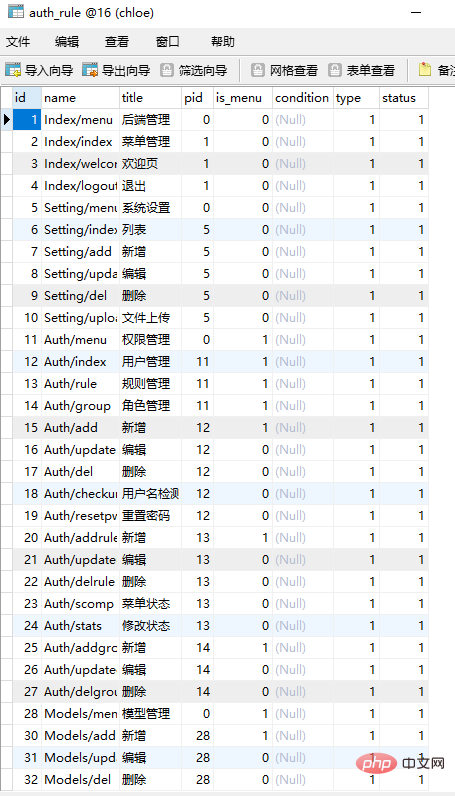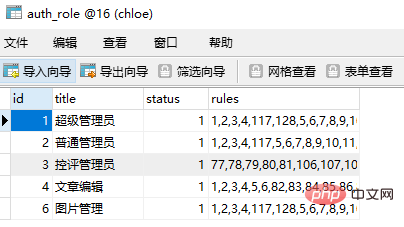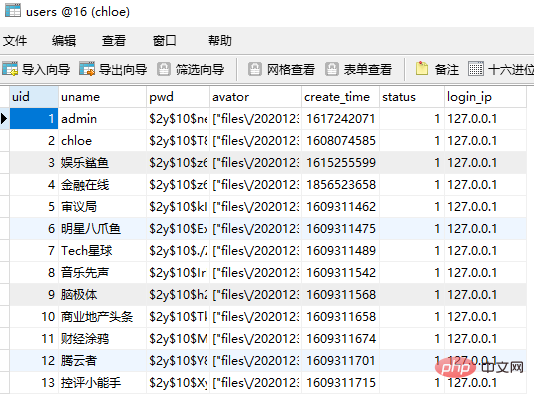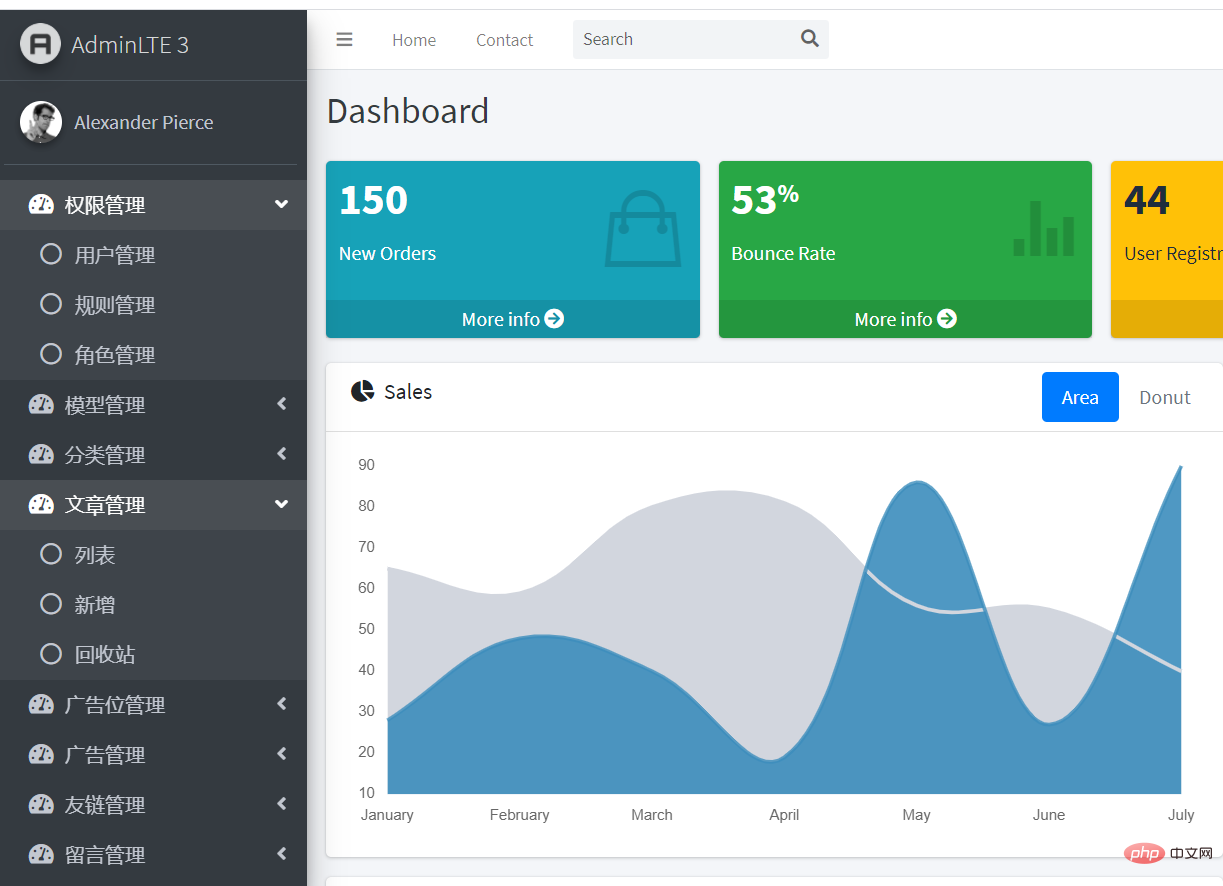rbac是英文role-based access control的首字母缩写,中文意思是基础角色的权限控制,它是一种思想,根据 rbac 思想进行数据表设计,更好的完成不同角色的对应的权限控制。
如何使用RBAC思想进行数据表的设计
如果我们的项目允许一个后台管理用户可能有1个或者2个及2个以上的多个角色,按照下面进行设计:

权限菜单表,角色表,用户表是互相独立的。设计表的顺序是权限菜单表,角色表,用户表,用户-角色关联表。
1. 首先是权限菜单表设计如下:
注意:权限菜单可以是多级菜单,添加pid字段,方便无限极递归分类。

2. 角色表设计如下:

3. 用户表设计如下:

4. 最后是用户-角色关联表设计如下:

当超级管理员在后台需要添加新用户时,不仅需要insert数据进用户表,也需要在用户-角色表中添加用户和角色的关系。与之对应,删除用户时,也需要将用户-角色表中对应的用户-角色关系删除。
public function add()
{
if(request()->isPost()){
$role_id = input('post.role_id');
$data = [
'uname'=>input('post.uname'),
'pwd'=>password_hash(input('post.pwd'),PASSWORD_BCRYPT),
'login_ip'=>request()->ip(),
'status'=>input('post.status'),
'create_time'=>time(),
];
$uid = Db::name('users')->insertGetId($data);
if($uid){
$data = [
'uid'=>$uid,
'role_id'=>$role_id
];
$id = Db::name('users_role')->insertGetId($data);
if($id)
{
echo 'true';
exit;
}else{
echo 'false';
exit;
}
}else{
echo 'false';
exit;
}
}else{
//获取所有角色
$role = Db::name('auth_role')->field('id,title')->order('id','asc')->where('status',1)->select();
return view('add',['role'=>$role]);
}
} 这样以来我们根据用户登录以后session中储存的uid判断当前登录用户的身份信息,根据获取到的uid查询用户-角色关联表查询到用户的角色id, 然后到角色表获取到该用户可操作的权限菜单。
封装中间控制器Common.php
<?php
namespace app\admin\controller;
use app\BaseController;
use think\facade\Session;
use lib\Auth;/**权限认证类**/
class Common extends BaseController
{
public function initialize(){
$sess_auth = session('uid');
$uname = session('uname');
//判断用户是否登录
if(!$sess_auth){
jumpTo('/login/index');
exit;
//检查到用户登录后, 还要检测该用户是否具有操作某个页面的权限, (是否具有操作某个方法的权限)
}else{
$auth = new Auth();
if(!$auth->check(request()->controller().'/'.request()->action(),$sess_auth)){
historyTo('抱歉~你没有操作该栏目的权限,请联系管理员!');
exit;
}
}
}
} lib\Auth;/**权限认证类**/
<?php
use think\facade\Db;
use think\facade\Config;
use think\facade\Session;
use think\facade\Request;
class Auth
{
protected $_config = [
'auth_on' => true, // 认证开关
'auth_type' => 1, // 认证方式,1为实时认证;2为登录认证。
'auth_role' => 'auth_role', // 用户组数据表名
'users_role' => 'users_role', // 用户-用户组关系表
'auth_rule' => 'auth_rule', // 权限规则表
'auth_user' => 'users', // 用户信息表
];
public function __construct()
{
if (Config::get('app.auth')) {
$this->_config = array_merge($this->_config, Config::get('app.auth'));
}
}
/**
* 检查权限
* @param string|array $name 需要验证的规则列表,支持逗号分隔的权限规则或索引数组
* @param integer $uid 认证用户ID
* @param string $relation 如果为 'or' 表示满足任一条规则即通过验证;如果为 'and' 则表示需满足所有规则才能通过验证
* @param string $mode 执行check的模式
* @param integer $type 规则类型
* @return boolean 通过验证返回true;失败返回false
*/
public function check($name, $uid, $relation = 'or', $mode = 'url', $type = 1)
{
if (!$this->_config['auth_on']) {
return true;
}
$authList = $this->getAuthList($uid, $type);
if (is_string($name)) {
$name = strtolower($name);
if (strpos($name, ',') !== false) {
$name = explode(',', $name);
} else {
$name = [$name];
}
}
$list = [];
if ($mode === 'url') {
$REQUEST = unserialize(strtolower(serialize($_REQUEST)));
}
foreach ($authList as $auth) {
$query = preg_replace('/^.+\?/U', '', $auth);
if ($mode === 'url' && $query != $auth) {
parse_str($query, $param); // 解析规则中的param
$intersect = array_intersect_assoc($REQUEST, $param);
$auth = preg_replace('/\?.*$/U', '', $auth);
if (in_array($auth, $name) && $intersect == $param) {
$list[] = $auth;
}
} elseif (in_array($auth, $name)) {
$list[] = $auth;
}
}
if ($relation === 'or' && !empty($list)) {
return true;
}
$diff = array_diff($name, $list);
if ($relation === 'and' && empty($diff)) {
return true;
}
return false;
}
/**
* 根据用户ID获取用户组,返回值为数组
* @param integer $uid 用户ID
* @return array 用户所属用户组 ['uid'=>'用户ID', 'group_id'=>'用户组ID', 'title'=>'用户组名', 'rules'=>'用户组拥有的规则ID,多个用英文,隔开']
*/
public function getGroups($uid)
{
static $groups = [];
if (isset($groups[$uid])) {
return $groups[$uid];
}
$user_groups = Db::name($this->_config['users_role'])
->alias('ur')
->where('ur.uid', $uid)
->where('ar.status', 1)
->join($this->_config['auth_role'].' ar', "ur.role_id = ar.id")
->field('uid,role_id,title,rules')
->select();
$groups[$uid] = $user_groups ?: [];
return $groups[$uid];
}
/**
* 获得权限列表
* @param integer $uid 用户ID
* @param integer $type 规则类型
* @return array 权限列表
*/
protected function getAuthList($uid, $type)
{
static $_authList = [];
$t = implode(',', (array)$type);
if (isset($_authList[$uid.$t])) {
return $_authList[$uid.$t];
}
if ($this->_config['auth_type'] == 2 && Session::has('_AUTH_LIST_'.$uid.$t)) {
return Session::get('_AUTH_LIST_'.$uid.$t);
}
// 读取用户所属用户组
$groups = $this->getGroups($uid);
$ids = []; // 保存用户所属用户组设置的所有权限规则ID
foreach ($groups as $g) {
$ids = array_merge($ids, explode(',', trim($g['rules'], ',')));
}
$ids = array_unique($ids);
if (empty($ids)) {
$_authList[$uid.$t] = [];
return [];
}
$map = [
['id', 'in', $ids],
['type', '=', $type],
['status', '=', 1]
];
// 读取用户组所有权限规则
$rules = Db::name($this->_config['auth_rule'])->where($map)->field('condition,name')->select();
// 循环规则,判断结果。
$authList = [];
foreach ($rules as $rule) {
if (!empty($rule['condition'])) { // 根据condition进行验证
$user = $this->getUserInfo($uid); // 获取用户信息,一维数组
$command = preg_replace('/\{(\w*?)\}/', '$user[\'\\1\']', $rule['condition']);
// dump($command); // debug
@(eval('$condition=('.$command.');'));
if ($condition) {
$authList[] = strtolower($rule['name']);
}
} else {
// 只要存在就记录
$authList[] = strtolower($rule['name']);
}
}
$_authList[$uid.$t] = $authList;
if ($this->_config['auth_type'] == 2) {
Session::set('_AUTH_LIST_'.$uid.$t, $authList);
}
return array_unique($authList);
}
/**
* 获得用户资料,根据自己的情况读取数据库
*/
protected function getUserInfo($uid) {
static $user_info = [];
$user = Db::name($this->config['auth_user']);
// 获取用户表主键
$_pk = is_string($user->getPk()) ? $user->getPk() : 'uid';
if (!isset($user_info[$uid])) {
$user_info[$uid] = $user->where($_pk, $uid)->find();
}
return $user_info[$uid];
}
} 这样就能实现路由操作权限的实时检测,比如我们让首页控制器继承中间控制器:
<?php
namespace app\admin\controller;
use think\Request;
use think\facade\Db;//db类
use think\facade\Session;
use lib\Rule;
class Index extends Common
{
public function index()
{
$uname = session('uname');
$uid = session('uid');
// 根据uid,获取该用户相应的权限,连表查询
$res = Db::name('users')->alias('u')->where('u.uid',$uid)
->leftJoin('users_role ur','ur.uid = u.uid')
->leftJoin('auth_role ar','ar.id = ur.role_id')
->field('u.uid,u.uname,ar.rules')
->select()->toArray();
// dd($res);
$rules = implode(",",array_column($res,'rules'));
// dd( $rules);
//in查询 根据获取到的rules id 选权限列表
$res = Db::name('auth_rule')->field('id,name,title,pid')->order('id','asc')->where('is_menu',1)
->where('id','in',$rules)->select();
// dump($res);
//这里使用扩展类Rule中封装的无限极分类方法
$rlist = Rule::Rulelayer($res);
// dd($rlist);
$data = [
'uid'=>$uid,
'uname'=>$uname,
'rlist'=>$rlist,
'create_time'=>1617252175
];
return view('index', $data);
}
}最终实现的效果如图:

以上就是RBAC权限控制实现原理——权限表、用户表与关联表设计的详细内容,更多请关注php中文网其它相关文章!


Copyright 2014-2024 https://www.php.cn/ All Rights Reserved | php.cn | 湘ICP备2023035733号